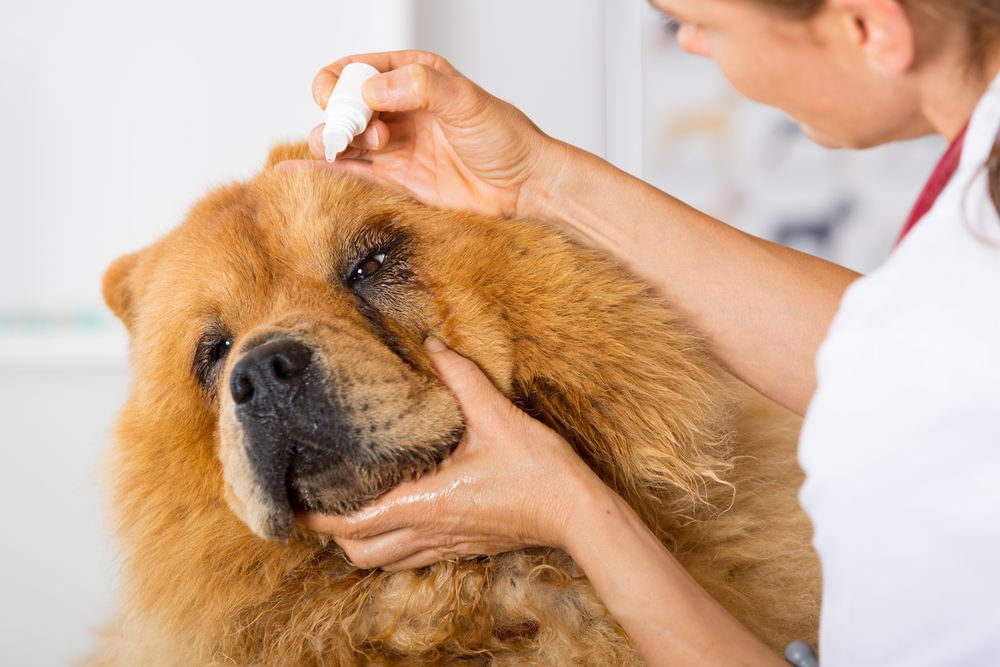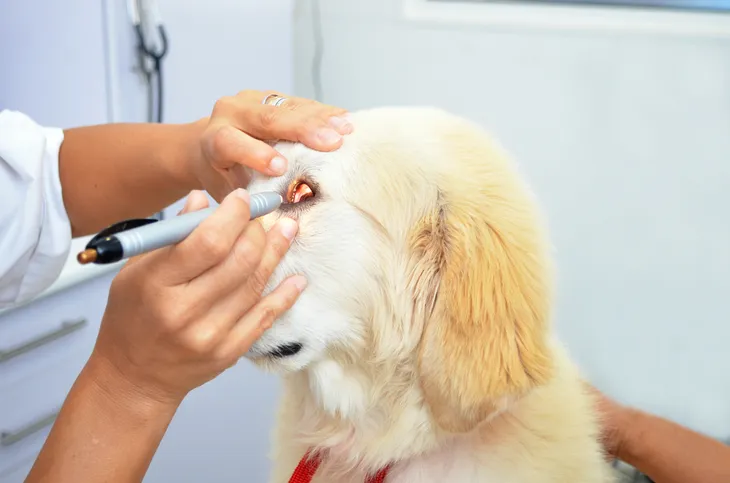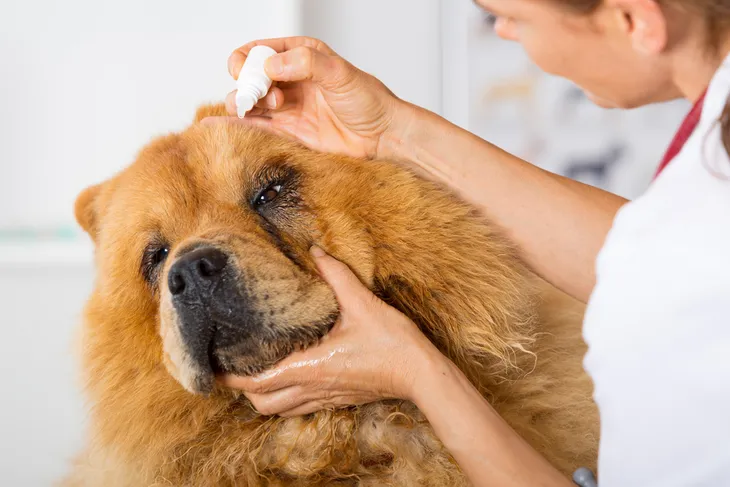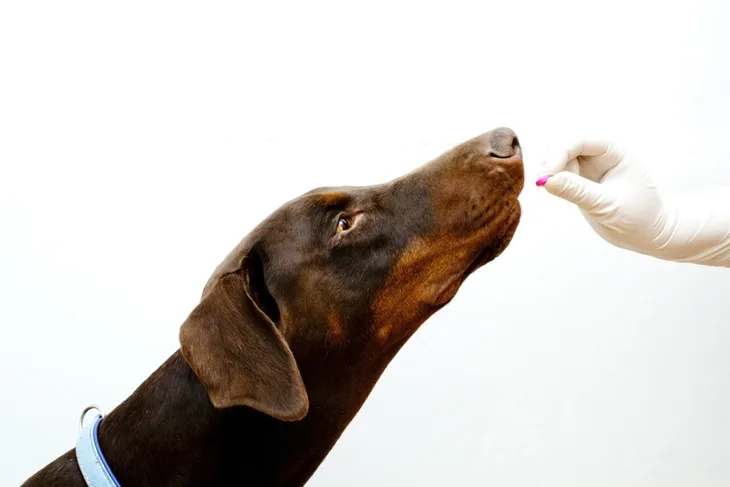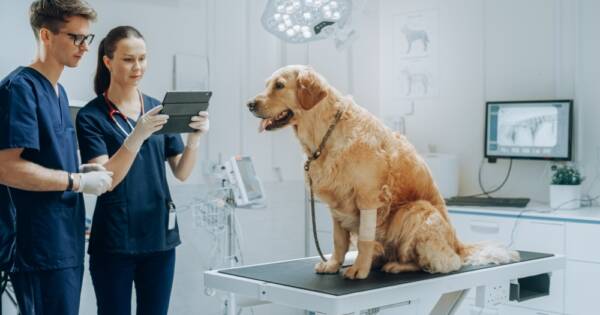Dogs are particularly prone to four types of eye infections. The first and most common type is conjunctivitis, also known as pink eye or red eye. Alternately, your dog may develop corneal inflammation. Third, uveitis is a type of eye infection that affects the iris and surrounding tissues. Finally, tear gland and eyelid injuries or abnormalities can cause infections.
It is important to note that many unrelated conditions, including glaucoma, poisoning, tumors, and vitamin deficiencies, can trigger symptoms similar to those produced by these four types of canine eye infections. For this reason, you should always consult a vet to make sure you get an accurate diagnosis and form a treatment plan that will address the correct problem.
Symptoms of Eye Infection in Dogs
The symptoms of canine eye infections are usually quite apparent, and typically include (note: treatment options are listed after the 7 symptoms below):
Symptom: Redness and Inflammation
All four of the major types of canine eye infections cause redness and inflammation (swelling) of the affected eye. This will be one of the condition’s most obvious symptoms, and you’ll notice it easily when you compare the affected eye to its healthy counterpart.
As an important precautionary note: never attempt to treat your dog’s red eyes using over-the-counter eye drops formulated for humans, such as Visine or its generic counterparts. These can cause serious irritation and injuries.
Symptom: Discharges From the Eye
The infected eye may generate a discharge, which can present in several different ways. One common manifestation is a watery discharge that differs from normal watering of the eye, as it will be far more abundant than regular watering and localized to the infected eye.
Alternately, the discharge may be thick and off-white or discolored. These types of thick discharges are usually accompanied by a foul and pungent odor.
Symptom: Squinting
Redness and swelling will occur in a large majority of canine eye infections, but even in the absence of a noticeable discharge, you should suspect an infection if your dog squints in only one eye. Infected eyes are often irritated and itchy, and your dog’s squinting represents an initial attempt to relieve its discomfort. This is a symptom of an eye infection that is in its relatively early stages, and has not yet become a serious problem.
Symptom: Excessive Blinking
In addition to squinting, you may notice your dog blinking to an excessive or even compulsive degree. Though most canine eye infections are localized to one side, your dog will probably blink both of its eyelids with rapid, constant frequency if this symptom is present.
If your dog is blinking excessively in the absence of other symptoms, it may be the sign of a temporary problem, such as debris or a small foreign object embedded in the eye. However, if the blinking continues over a period of days, it may be infection-related.
Symptom: Photosensitivity
Photosensitivity is the technical term for sensitivity to light. Dogs with eye infections often have noticeable reactions to bright light, both of the indoor artificial variety and the natural variety. Symptoms are likely to be most noticeable when your dog moves from an area with lower light into an area with bright light.
In most cases, photosensitive dogs with eye infections will react to bright light by squinting, closing their eyes, or burying their heads under their paws to try to shield their eyes from the light.
Symptom: Keeping the Affected Eye Closed
Whether due to photosensitivity, itchiness, irritation, or a combination of these, your dog may simply opt to deal with its discomfort by keeping the infected eye closed. The problem with this symptom is that your dog may turn to closing its eye before you’ve noticed any of the other symptoms, and you may find yourself trying to pry or force your dog’s eye open to have a look. If you must do this, do it gently, as your dog’s eye will be highly sensitive. Better yet, let your vet handle it.
Symptom: Pawing or Scratching at the Eye
The swelling and itchiness associated with canine eye infections often results in pets pawing at or scratching the affected eye. This is undesirable for two reasons. First, your dog could injure itself if a sharp part of its paw comes into rough contact with a surface portion of its eye. Second, your dog’s paws are likely to be dirty, and when it introduces that dirt to its eye, it risks making the infection worse.
Treatments for Eye Infections in Dogs
Your vet may recommend one or more of the following treatment options:
Treatment Option: Get an Accurate Diagnosis
This important first step is less obvious than it sounds, since there is a long list of unrelated canine eye conditions that cause symptoms similar to those seen in eye infections. After a visual examination, one of the first things your vet will do if he or she suspects a bacterial infection is perform a culture test to see what type of microbial agent is causing the problem.
If no microbial agent is found, your vet will investigate other possible causes of your pet’s symptoms. Other diagnostic tests for eye infections include dilation, corneal staining, allergy tests, and tests that measure tear production and tear contents.
Treatment Option: Treat the Underlying Cause(s)
As part of the diagnostic process, your vet may also attempt to determine the underlying cause of your dog’s eye infection if it is not obvious. This is because many things, including viruses, allergies, chemical and environmental irritants, and eye trauma, can all lead to infections. Correctly identifying the cause of your pet’s condition is crucial not only to treating it, but also to preventing recurrent infections in the future.
Treatment Option: Apply Topical Medications
Specially formulated canine eye drops may be used to help clear the eye infection. In cases of conjunctivitis, these eye drops will contain antibacterial medications. Other types of drops use compounds known as corticosteroids to help your dog’s healthy eye tissues make a faster recovery.
It is important to use these drops exactly as directed. Do not apply them less frequently or more frequently than your vet recommends, or you may worsen the situation.
Treatment Option: Use Systemic Drugs to Fight the Infection
Your vet may prescribe systemic drugs, such as orally ingested antibiotics to treat the eye infection. These drugs may be used in addition to topical treatments, or in place of topical treatments. The exact treatment plan your vet prescribes will depend on the underlying cause of the infection, and the nature of the infectious agent.
If your pet is prescribed antibiotics, make sure to administer the full course of treatment to your dog, even if symptoms clear up before your pet has finished the drugs. Otherwise, the infection may simply come back.
Treatment Option: Prevent Recurrent and Future Infections
There are several things you can do to prevent canine eye infections from recurring in the future. First, take steps to limit your dog’s exposure to debris and foreign objects. One of the best ways to do this is to disallow your dog to put its head out the window when you are driving with your pet in the car. High-speed flying debris is a major cause of canine eye injuries and infections.
You should also wipe your dog’s face regularly to keep it clean, and trim the fur around its eyes so it is short and out of the way. If your dog remains prone to eye infections despite these preventative measures, you can also get specially designed goggles that will help keep irritants and particulate matter out of your dog’s eyes.
